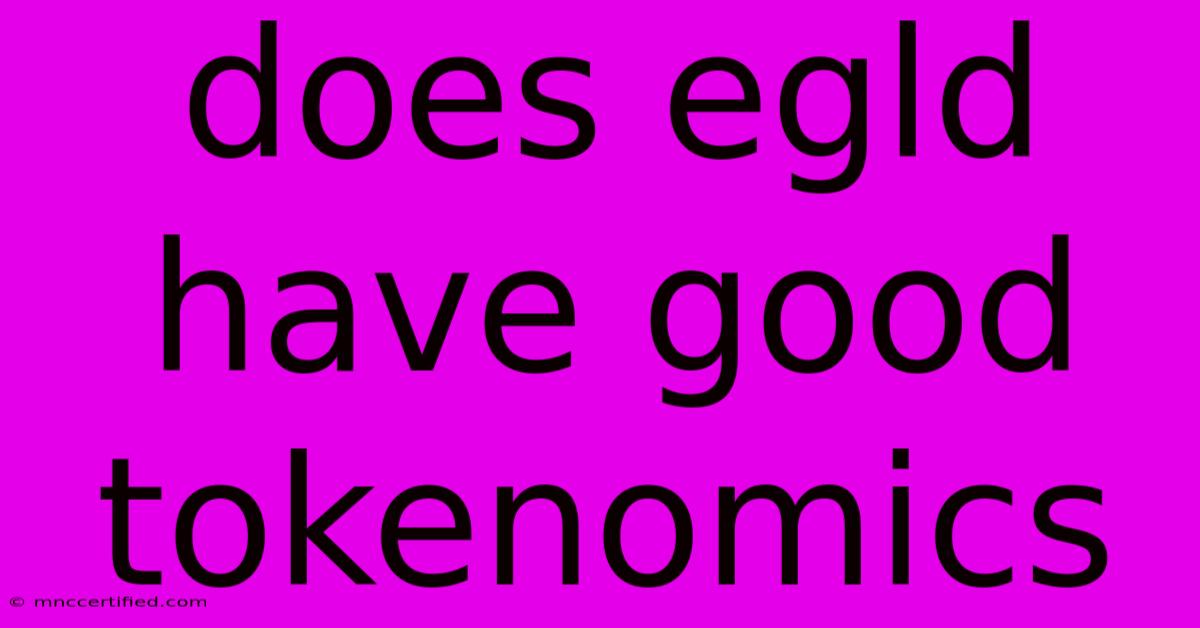Does Egld Have Good Tokenomics

Table of Contents
Does EGLD Have Good Tokenomics? A Deep Dive into Elrond's Economic Model
Elrond (EGLD) has garnered significant attention in the cryptocurrency space, but a crucial aspect often debated is its tokenomics. Does EGLD's economic model truly support long-term growth and value? This article delves deep into Elrond's tokenomics, examining its strengths and weaknesses to provide a comprehensive assessment.
Understanding Elrond's Tokenomics: Key Features
Elrond's tokenomics are designed to incentivize network participation, secure the blockchain, and foster a thriving ecosystem. Key elements include:
-
Staking: EGLD holders can stake their tokens to secure the network and earn rewards. This mechanism ensures network decentralization and provides a passive income stream for token holders. The high staking rewards initially attracted many users, but the APY has naturally decreased as the network matures. This is a common occurrence in Proof-of-Stake (PoS) systems.
-
Transaction Fees: Transactions on the Elrond network incur fees, a portion of which goes to validators (stakers) and a portion is burned. This burn mechanism reduces the circulating supply of EGLD over time, potentially increasing its value. The effectiveness of this burn mechanism depends on network usage and transaction volume.
-
Network Governance: EGLD holders have governance rights, allowing them to participate in decisions regarding the network's development and future. This feature encourages community involvement and ensures the network adapts to evolving needs.
-
Inflationary Model (Initially): While Elrond started with an inflationary model, the burning mechanism helps to offset inflation. The overall balance between inflation and burning is a key factor to watch in assessing the long-term sustainability of EGLD's value. The long-term goal is to approach a deflationary model.
Strengths of EGLD's Tokenomics
-
High Staking Rewards (Historically): While reduced now, the high initial staking rewards attracted a large and active community, strengthening network security and decentralization.
-
Built-in Burn Mechanism: The consistent burning of transaction fees helps control inflation and potentially increase EGLD's scarcity over time. This is a crucial element differentiating Elrond from many other cryptocurrencies.
-
Strong Community Engagement: Elrond boasts a dedicated and active community, actively participating in governance and network development. This fosters a robust and resilient ecosystem.
-
Focus on Scalability: Elrond's focus on scalability, through its sharding technology, ensures the network can handle a high volume of transactions, making the burning mechanism potentially more effective.
Weaknesses of EGLD's Tokenomics
-
APY Fluctuation: The APY for staking EGLD has decreased significantly since launch, potentially discouraging some stakers. This is a natural consequence of network growth and increasing staking participation.
-
Dependence on Transaction Volume: The effectiveness of the burn mechanism is directly tied to the volume of transactions on the Elrond network. Low transaction volume could limit the burn rate and negate its inflationary counterbalance.
-
Competition in the DeFi Space: The cryptocurrency market is highly competitive, and Elrond faces stiff competition from other blockchain platforms offering similar services and incentives.
Conclusion: Is EGLD's Tokenomics Model Good?
Elrond's tokenomics presents a mixed picture. While the initial high staking rewards and built-in burn mechanism were attractive, the decreasing APY and dependence on high transaction volume present challenges. The long-term success of EGLD's tokenomics hinges on the sustained growth and adoption of the Elrond network, maintaining a balance between inflation and burning, and adapting to the competitive landscape of the blockchain industry. It's important to conduct thorough research and consider the inherent risks before investing in any cryptocurrency. Whether or not EGLD’s tokenomics are “good” is ultimately a subjective assessment based on individual investment strategies and risk tolerance. Ongoing monitoring of network activity and developments is crucial for any informed decision.

Thank you for visiting our website wich cover about Does Egld Have Good Tokenomics. We hope the information provided has been useful to you. Feel free to contact us if you have any questions or need further assistance. See you next time and dont miss to bookmark.
Featured Posts
-
State Farm Beekeeping Insurance
Nov 26, 2024
-
Sir Rod Stewart Glastonbury 2025
Nov 26, 2024
-
Bumrahs 2024 A Dream Run
Nov 26, 2024
-
81k A Year Is How Much An Hour
Nov 26, 2024
-
Institutional Tools For Trading
Nov 26, 2024